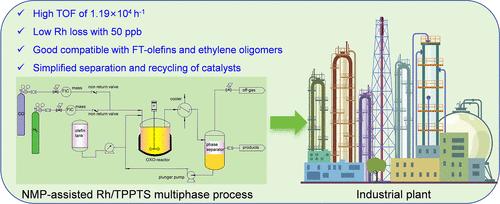克服共溶剂在铑催化的基于nmp的多相氢甲酰化中的挑战:催化剂性能、寿命和工业生产可扩展性的研究
IF 3.9
3区 工程技术
Q2 ENGINEERING, CHEMICAL
引用次数: 0
摘要
本研究提出了一种新型的助溶剂体系,该体系由Rh-TPPTS [P(m-C6H4SO3Na)3]与n -甲基-2-吡咯烷酮(NMP)多相催化长链烯烃氢甲酰化反应。1-辛烯在nmp -水中的溶解度(v/v 7/3)约为纯水的36000倍;因此,该催化体系表现出优异的性能,在温和条件下(30 ppm Rh),其转换频率为1.19 × 104 h-1,壬醛选择性超过94%,线性-分支(L/B)比为2.6。值得注意的是,产品中残留的铑催化剂(0.22 ppm)和NMP浸出(8 wt %)可以通过萃取过程几乎完全回收和再循环,而不会形成缩合副产物。这有效地解决了与醇共溶剂系统相关的挑战。该催化剂连续运行150 h,总周转量为278,547,空时产率为77 kg m-3 h - 1,是一种具有环境可持续性和经济效益的多相催化工艺。此外,对催化剂失活机理的研究表明,保持适当的P/Rh比和反应温度是保证铑催化剂寿命的关键。将实验室规模的成功与工业实践相结合,可能为未来在工业过程中的应用铺平道路。本文章由计算机程序翻译,如有差异,请以英文原文为准。

Overcoming Cosolvent Challenges in Rhodium-Catalyzed NMP-Based Multiphase Hydroformylation: A Study on Catalyst Performance, Longevity, and Scalability for Industrial Production
This study presents a novel cosolvent system for the hydroformylation of long-chain olefins catalyzed by Rh-TPPTS [P(m-C6H4SO3Na)3] in multiphase with N-methyl-2-pyrrolidone (NMP). The solubility of 1-octene in NMP-water (v/v 7/3) is approximately 36,000 times greater than that in pure water; therefore, this catalytic system demonstrates remarkable performances with an excellent turnover frequency of 1.19 × 104 h–1, nonanal selectivity exceeding 94%, and a moderate linear-to-branch (L/B) ratio of 2.6 under mild conditions (30 ppm of Rh). Notably, the residual rhodium catalyst (0.22 ppm) and NMP leaching (8 wt %) in the products can be nearly completely recovered and recycled through an extraction process, with no condensation byproducts formed. This effectively addresses the challenges associated with alcohol cosolvent systems. The catalyst achieved a total turnover number of 278,547 and a space-time yield of 77 kg m–3 h–1 during continuous operation over 150 h, highlighting a multiphase catalytic process with environmental sustainability and economic efficiency. Furthermore, the investigation into the catalyst deactivation mechanism indicates that maintaining an appropriate P/Rh ratio and reaction temperature is essential for ensuring the longevity of rhodium catalysts. The integration of lab-scale success with industrial practice may pave the way for future application to industrial processes.
求助全文
通过发布文献求助,成功后即可免费获取论文全文。
去求助
来源期刊

Industrial & Engineering Chemistry Research
工程技术-工程:化工
CiteScore
7.40
自引率
7.10%
发文量
1467
审稿时长
2.8 months
期刊介绍:
ndustrial & Engineering Chemistry, with variations in title and format, has been published since 1909 by the American Chemical Society. Industrial & Engineering Chemistry Research is a weekly publication that reports industrial and academic research in the broad fields of applied chemistry and chemical engineering with special focus on fundamentals, processes, and products.
 求助内容:
求助内容: 应助结果提醒方式:
应助结果提醒方式:


